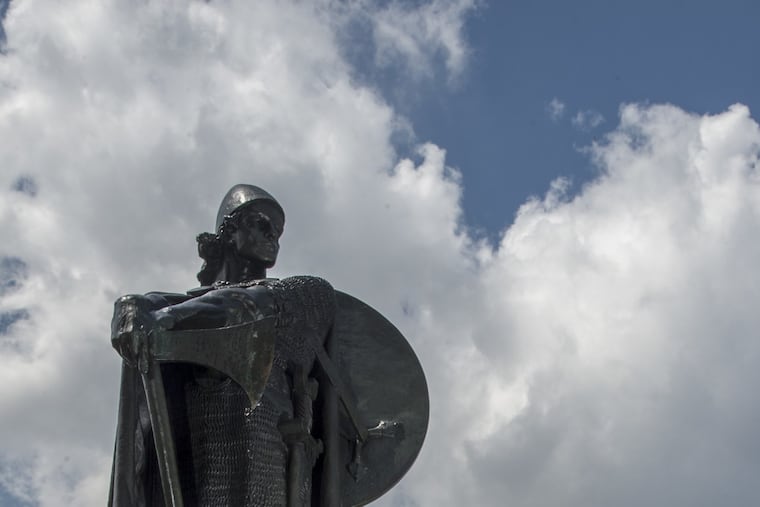What white nationalists get wrong about the Vikings | Opinion
Not only are the contemporary descendants of the Vikings among the least fascist-inclined people on earth, but even the ancient Vikings were among the least-inclined among their contemporaries to support Nazi values.

On Tuesday morning, Fairmount Park's monument of Thorfinn Karlsefni, a Viking explorer, was toppled off his pedestal and into the Schuylkill. Though motives behind this toppling are currently unknown, the bronze has been controversial in recent years. It's been a meeting place for white nationalist gatherings and last year was spray-painted with anti-Nazi language.
White supremacists have chosen the wrong symbol for their views. Not only are the contemporary descendants of the Vikings among the least fascist-inclined people on earth, but even the ancient Vikings were among the least-inclined of their contemporaries to support Nazi values.
It's understandable that white supremacists in the early 1900s would want to find an ancient people to turn into their heroes — that's what most culture workers do to legitimate their beliefs. Think of the role of ancient Jews for Christians, the Amazons for feminists, the ancient Greeks for 19th-century upper-class British, and African civilizations for some African Americans. Of course the white supremacists chose the Vikings, who were as white as could be — even blond and blue-eyed!
It's doubtful that the ancient Vikings were any more prone to rape and plunder than most other tribes in the eighth to 11th centuries, but their technological edge (especially state-of-the-art ships) made them appear the toughest of all.
Nazi ideology conveniently left out the rest: their remarkably egalitarian ethos, again relative to a time when slavery was commonplace. The equality, rough as it was, grew out of Viking circumstances. Viking husbands were often away on expeditions, leaving their wives in charge of farms and community life. Viking women learned leadership skills, made major decisions, gained the right to divorce their men, became to a remarkable degree partners instead of servants.
The expeditions themselves put a premium on teamwork — the good for one was dependent on the common good — and tyrannical leadership gave way to more or less cooperative leadership. Immigration into Scandinavia was met with respect because the margin of life there was narrow and helpful skills were needed.
Although Viking society was far from a socialist paradise, neither was it a place that justifies the Nazi ideology of violent, misogynistic white tyranny.
In fact, a century ago, Nordic descendants inspired themselves by emphasizing that Vikings, in their expeditions, went where no one had gone before, thereby justifying the value of innovation. In the 1930s, modern Vikings invented what economists call "the Nordic economic model," the most egalitarian in history.
Their new economy, it turns out, does much better than the Anglo-American model decade after decade on most measures of societal well-being. The best place in the world to be a mom. The best place to be a senior. The best education. The most free press. Free higher education. Universal, high-quality medical care. Virtual elimination of poverty. Highest achievement in addressing climate change. Longest paid parental leave. Longest paid vacation. The world's happiest people. The least corrupt, most democratic government. The highest life expectancy.
Only Norway found a treasure trove of oil, yet all the Nordics excel in the ratings. Norway has more start-ups per capita than the U.S. Sweden has more patents per capita than the U.S. Both countries have a higher percentage of foreign-born than the U.S.
"The American Dream" has moved across the Atlantic, where the Nordics have much higher social mobility than the U.S.
Inspired by the ancients, modern Vikings did the rest of us a favor by inventing what we need now: an economic model that prioritizes the common good.
George Lakey recently retired from teaching at Swarthmore College, where he was the Eugene M. Lang Professor for Issues in Social Change, and is author of "Viking Economics: How the Scandinavians Got It Right and How We Can, Too" (Melville House, 2016).